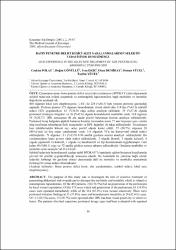| dc.contributor.author | Polat, Coşkun | |
| dc.contributor.author | Gönüllü, Doğan | |
| dc.contributor.author | Ekiz, Feza | |
| dc.contributor.author | Demiray, Okan | |
| dc.contributor.author | Yücel, Osman | |
| dc.date | 2015-01-22 | |
| dc.date.accessioned | 2015-01-22T14:37:43Z | |
| dc.date.available | 2015-01-22T14:37:43Z | |
| dc.date.issued | 2003-07 | |
| dc.identifier.issn | 1302-4612 | |
| dc.identifier.uri | http://hdl.handle.net/11630/1663 | |
| dc.description.abstract | Çalışmanın amacı batın penetre delici kesici alet yaralanması (BPDKAY) olan olgularında selektif tedavinin rolünü araştırmak ve nonterapötik laparotomilere bağlı morbidite ve mortalite değerlerini azaltmak idi.
403 olgunun lokal yara eksplorasyonu (LYE) ile 228 (%56.5)’inde yaranın peritonu geçmediği saptandı. Peritone penetre 175 olgunun hemodinamik olarak stabil olan 114’üne (%65.1) selektif tedavi (ST) uygulanırken; 61 (%34.9) olgu acilen ameliyat edilmiştir. 35 (%57.4) olguda peritoneal irritasyon bulguları ve 26 (%42.6) olguda hemodinamik instabilite vardı. 114 olgunun 35 (%30.7)’i DPL sonucunun ilk altı saatte pozitif bulunması üzerine ameliyat edilmişlerdir. Peritoneal lavaj bulguları şüpheli bulunan hastalar travmadan sonra 72 saat boyunca aynı cerrahi ekip tarafından tekrarlayan fizik muayeneler ve DPL değerleri ile takip edilmişlerdir. Tekrarlanan kan tetkiklerindeki lökosit sayı artışı pozitif olarak kabul edildi. 35 (30.7%) olgunun 28 (80%)’inde içi boş organ yaralanması vardı. 114 olgunun 79’u ise konservatif olarak tedavi edilmişlerdir. 79 olgunun 11’i (%13.9) 8-96 saatlik gecikme sonrası ameliyat edilmişlerdir. Bu yaralanmaların hepsi primer sütür tedavi edilmişlerdir. 3 olguda ileorafi, 3 olguda kolorafi, 4 olguda jejunorafi ve kolorafi, 1 olguda ise duodenorafi ve tüp duodenostomi uygulanmıştır. Geri kalan 68 (%86.1) olgu ise 72 saatlik gözlem sonrası taburcu edilmişlerdir. Ortalama morbidite ve mortalite oranı sırasıyla %6.9ve 0.6 idi.
Selektif tedavinin hemodinamik açıdan stabil BPDKAY’lı hastalarda eğitim hastanesi koşullarında güvenli bir şekilde uygulanabileceği sonucuna ulaştık. Bu hastalarda bu yönteme bağlı olarak tedavide herhangi bir gecikme olması durumunda dahi bu mortalite ve morbidite oranlarında herhangi bir artışa neden olmamaktadır. | en_US |
| dc.description.abstract | The purpose of this study was to investigate the role of selective treatment of penetrating abdominal stab wounds and to decrease the morbidity and mortality which is related to nonterapeutic laparotomies. Of the 403 patients, 228 (56.5%) had no penetration of the peritoneum by local wound exploration. Of the 175 cases which had penetration of the peritoneum, 61 (34.9%) cases were operated immediately while of the 114 (65.1%) were treated selectively. There were peritoneal irritation findings in 35 (57.4%) cases and hemodynamic instability in 26 (42.6%) cases. Of 114 (65.1%) cases, 35 (30.7%) were operated after DPL has been found positively in initial six hours. The patients who had suspicious peritoneal lavage signs had been evaluated with repeated physical examinations and DPL values by the same surgical team, for 72 hours after trauma. Increased WBC counts on repeated hemograms were considered positively. Of the 35 (30.7%) patients, 28 (80%) had hollow organ injuries. Of the 114 patients, 79 (69.3%) have been treated conservatively. Of 79 cases, 11 (13.9%) have been operated at 8-96 hours delay. All of these injuries were managed with primary sutures. Ileoraphy in 3 cases, coloraphy in 3 cases, jejunoraphy and coloraphy in 4 cases, duodenoraphy and duodenostomy in 1 case were performed. But 68 (59.6%) patients have been discharged after 72 hours observation. In patients were operated within the first 6 hours, there were wound suppurations in four cases, anastomotic leaks in two cases and intestinal obstruction in one case. In patients were operated after 6 hours, there were wound suppurations in two cases, pneumonia in one case and evisceration in one case. Mean morbidity and mortality rates were 6.9%, 0.6%, respectively.
We concluded that selective treatment may be applied safely in hemodynamically stable patients with penetrating abdominal stab wounds in teaching hospitals. In these patients, if the treatment is even delayed due to this method, it has not been caused any increase in morbidity and mortality rates. | en_US |
| dc.language.iso | tur | en_US |
| dc.publisher | Afyon Kocatepe Üniversitesi, Kocatepe Tıp Dergisi | en_US |
| dc.rights | info:eu-repo/semantics/openAccess | en_US |
| dc.subject | Batın Penetre Delici Kesici Alet Yaralanmaları | en_US |
| dc.subject | Selektif Tedavi | en_US |
| dc.subject | Lokal Yara Eksplorasyonu | en_US |
| dc.title | Batın penetre delici kesici alet yaralanmalarının selektif tedavisinde deneyimimiz | en_US |
| dc.title.alternative | Our experience in the selective treatment of the penetrating abdominal stab wounds | en_US |
| dc.type | article | en_US |
| dc.relation.journal | Afyon Kocatepe Üniversitesi, Kocatepe Tıp Dergisi | en_US |
| dc.department | Afyon Kocatepe Üniversitesi, Tıp Fakültesi, Genel Cerrahi Anabilim Dalı | en_US |
| dc.identifier.volume | 4 | en_US |
| dc.identifier.startpage | 39 | en_US |
| dc.identifier.endpage | 47 | en_US |
| dc.identifier.issue | 2 | en_US |
| dc.relation.publicationcategory | Makale - Ulusal Hakemli Dergi - Kurum Yayını | en_US |



















